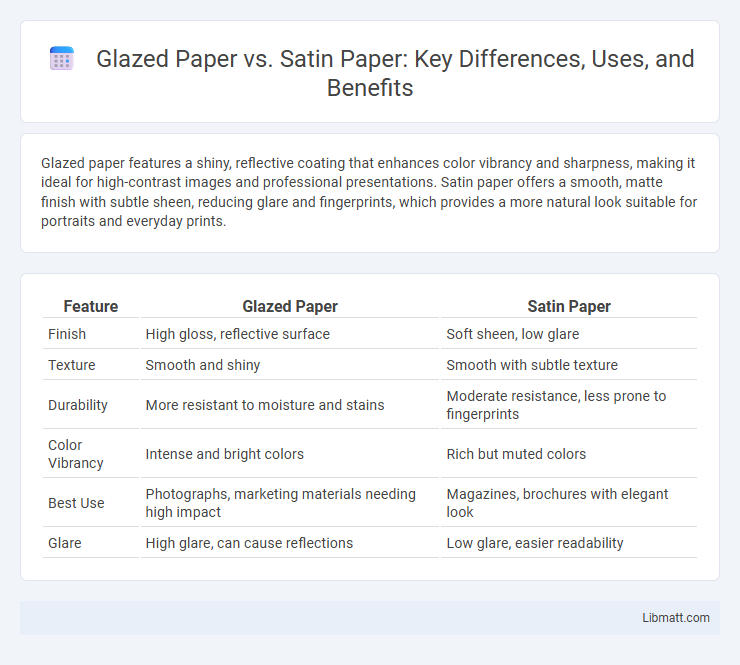Glazed paper features a shiny, reflective coating that enhances color vibrancy and sharpness, making it ideal for high-contrast images and professional presentations. Satin paper offers a smooth, matte finish with subtle sheen, reducing glare and fingerprints, which provides a more natural look suitable for portraits and everyday prints.
Table of Comparison
| Feature | Glazed Paper | Satin Paper |
|---|---|---|
| Finish | High gloss, reflective surface | Soft sheen, low glare |
| Texture | Smooth and shiny | Smooth with subtle texture |
| Durability | More resistant to moisture and stains | Moderate resistance, less prone to fingerprints |
| Color Vibrancy | Intense and bright colors | Rich but muted colors |
| Best Use | Photographs, marketing materials needing high impact | Magazines, brochures with elegant look |
| Glare | High glare, can cause reflections | Low glare, easier readability |
Introduction to Glazed Paper and Satin Paper
Glazed paper features a high-gloss, reflective finish that enhances color vibrancy and sharpness, making it ideal for photo prints and marketing materials requiring visual impact. Satin paper offers a smooth, semi-gloss surface that balances sheen and texture, reducing glare while maintaining rich color reproduction, perfect for professional presentations and art prints. Choosing the right paper for Your print projects depends on the desired aesthetic and functional qualities related to how light interacts with the paper's surface.
Key Differences Between Glazed and Satin Paper
Glazed paper features a high-gloss finish that enhances color vibrancy and sharpness, making it ideal for photo prints and marketing materials requiring a striking appearance. Satin paper offers a smooth, semi-matte surface that reduces glare and fingerprints, providing a more subtle and professional look suited for portraits and business documents. Understanding these key differences can help you choose the best paper type for your specific printing needs.
Material Composition and Manufacturing Process
Glazed paper features a high-gloss coating created by applying a clay and calcium carbonate mixture, followed by a calendaring process that smooths and compresses the surface to enhance shine and durability. Satin paper, on the other hand, uses a matte or semi-gloss coating composed of pigment and binders that provide a softer, less reflective finish, achieved through a gentler smoothing process without heavy calendaring. Understanding these differences in material composition and manufacturing helps you choose the right paper type for your printing needs, balancing appearance with texture and finish.
Appearance and Texture Comparison
Glazed paper features a highly reflective, glossy surface that enhances color vibrancy and sharpness, making images appear more vivid and polished. Satin paper offers a smooth, semi-gloss finish with subtle sheen, providing a softer appearance and reducing glare while maintaining color accuracy. Both papers differ in texture, with glazed paper feeling slick and smooth, whereas satin paper provides a slightly textured, velvety touch ideal for photographic prints and professional presentations.
Print Quality and Color Reproduction
Glazed paper features a shiny, reflective surface that enhances color vibrancy and sharpness, making images appear more vivid and detailed. Satin paper offers a balanced finish with a subtle sheen, providing rich color reproduction while minimizing glare and fingerprints. Choosing between the two depends on whether your priority is high contrast and brilliance or a softer, more elegant look with excellent print quality.
Durability and Resistance Features
Glazed paper offers superior durability due to its glossy, protective coating that resists moisture, fingerprints, and scratches, making it ideal for high-traffic or frequently handled prints. Satin paper provides moderate resistance with a smooth, semi-matte finish that balances protection against scuffs and fading while maintaining a softer appearance. Both options enhance print longevity, but glazed paper excels in environments requiring maximum durability and resistance to environmental factors.
Common Applications and Uses
Glazed paper is commonly used for high-quality photo prints, postcards, and marketing materials due to its glossy finish that enhances color vibrancy and sharpness. Satin paper finds application in professional photography, fine art prints, and brochures where reducing glare and fingerprint visibility is important while maintaining a smooth texture. Your choice depends on whether you prefer a shiny surface for vivid images or a subtle sheen for more sophisticated presentations.
Cost and Availability
Glazed paper generally costs more than satin paper due to its high-gloss finish and specialized coating process. Satin paper is widely available and often preferred for budget-conscious printing projects because it balances cost with quality and durability. Both types are commonly found in office supply stores and online, but satin paper offers more economical options for bulk purchases.
Environmental Impact and Recyclability
Glazed paper undergoes heavy coating and chemical treatments that reduce its recyclability and increase environmental impact due to non-biodegradable residues. Satin paper, with a lighter coating, is more easily recyclable and generates less waste throughout its lifecycle, making it a greener choice. When selecting materials, consider the reduced environmental footprint satin paper offers for your printing projects.
Choosing the Right Paper for Your Needs
Glazed paper offers a glossy finish that enhances color vibrancy and sharpness, making it ideal for photo prints and marketing materials requiring a polished look. Satin paper provides a subtle sheen with reduced glare and fingerprints, perfect for professional presentations and everyday printing needs. Selecting the right paper depends on your project's purpose, with glazed paper suited for vivid imagery while satin paper balances quality and versatility for your documents.
Glazed paper vs satin paper Infographic

 libmatt.com
libmatt.com